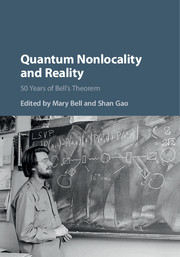Book contents
- Frontmatter
- Contents
- Contributors
- Preface
- Preface
- Part I John Stewart Bell: The Physicist
- 1 John Bell – The Irish Connection
- 2 Recollections of John Bell
- 3 John Bell: Recollections of a Great Scientist and a Great Man
- Part II Bell's Theorem
- Part III Nonlocality: Illusion or Reality?
- Part IV Nonlocal Realistic Theories
- Index
- References
3 - John Bell: Recollections of a Great Scientist and a Great Man
from Part I - John Stewart Bell: The Physicist
Published online by Cambridge University Press: 05 September 2016
- Frontmatter
- Contents
- Contributors
- Preface
- Preface
- Part I John Stewart Bell: The Physicist
- 1 John Bell – The Irish Connection
- 2 Recollections of John Bell
- 3 John Bell: Recollections of a Great Scientist and a Great Man
- Part II Bell's Theorem
- Part III Nonlocality: Illusion or Reality?
- Part IV Nonlocal Realistic Theories
- Index
- References
Summary
Introduction
This contribution to the book in honour of J. S. Bell will probably differ from the remaining ones, in particular since only a part of it will be devoted to specific technical arguments. In fact I have considered it appropriate to share with the community of physicists interested in the foundational problems of our best theory the repeated interactions I had with him in the last four years of his life, the deep discussions in which we have been involved in particular in connection with the elaboration of collapse theories and their interpretation, and the contributions he gave to the development of this approach at a formal level, as well as championing it on repeated occasions. In brief, I intend to play here the role of one of those lucky persons who became acquainted with him personally, who has exchanged important views with him, who has learned a lot from his deep insight and conceptual lucidity, and, last but not least, whose scientific work has been appreciated by him.
Moreover, due to the fact that this book intends to celebrate the 50th anniversary of the derivation of the fundamental inequality which bears his name, I will also devote a small part of the text to recalling his clearcut views about the locality issue, views that I believe have not been grasped correctly by a remarkable part of the scientific community. I will analyze this problem in quite general terms at the end of the paper.
Some of Bell's Scientific Achievements
Bell received bachelor's degrees in experimental physics and in mathematical physics at Queen'sUniversity of Belfast in the years 1948 and 1949, respectively, and a PhD in physics at the University of Birmingham. We all know very well that already at that time he was absolutely unsatisfied with the conceptual structure of quantum mechanics and with the way in which it was taught. This is significantly expressed by the statement he made during an interview to Jeremy Bernstein: I remember arguing with one of my professors, a Doctor Sloane, about that. I was getting very heated and accusing him, more or less, of dishonesty. He was getting very heated too and said, ‘You're going too far.’
- Type
- Chapter
- Information
- Quantum Nonlocality and Reality50 Years of Bell's Theorem, pp. 25 - 46Publisher: Cambridge University PressPrint publication year: 2016



